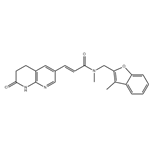Description
AFN-1252 is an inhibitor of staphylococcal enoyl-acyl carrier protein reductase (FabI; K
i = 12.8 nM), an enzyme that activates bacterial fatty acid biosynthesis. It is selective for isolates of methicillin-susceptible and methicillin-resistant
S. aureus (MIC
90s = ≤0.008 μg/ml) over isolates of
S. pneumoniae, β-hemolytic streptococci,
Enterococcus,
Enterobacteriaceae, non-fermentative Gram-negative bacilli, and
M. catarrhalis (MIC
90s = >4 μg/ml).
In vivo, AFN-1252 increases survival in a murine acute lethal septicemia model, showing 100% survival when administered at a single oral dose of 1 mg/kg.
Enzyme inhibitor
This selective, orally available, first-in-class antibiotic (FW = 375.43 g/mol; CAS 620175-39-5; Formulated in 1% Poloxamer 407) is a potent inhibitor of Staphylococcus aureus enoyl-acyl carrier protein reductase (FabI), thereby preventing fatty acyl chain elongation and disrupting biosynthesis of both saturated and unsaturated fatty acids needed for bacterial growth. It demonstrates exceptional potency and specificity against staphylococcal isolates, with typical S. aureus MIC ranges of 0.002–0.12 μg/mL and MIC90s of ≤ 0.015 μg/mL. Mode of Action: FabI is the only enoyl-ACP reductase in S. aureus, S. epidermidis, and related staphylococci, with no alternative enzyme or rescue pathway, including processing of exogenously supplied fatty acids. Such metabolic features suggest FabI may be essential to cell viability in Staphylococcus spp. The inhibitor’s target was convincingly confirmed (a) by using direct enzyme assays (IC50 = 14 nM, with no inhibition of the human enzyme, even at 67 μM); (b) by employing radiolabeled acetate to demonstrate that AFN-1252 greatly reduced incorporation into lipids; (c) by co-crystallizing AFN-1252 and FabI in the presence of the unnatural substrate 3′-NADPH, and (d) by genetically determining AFN-1252’s spontaneous resistance frequency and characterizing AFN-1252-resistant FabI mutants. In socalled time-kill assays, AFN-1252 caused a time-dependent reduction in the viability of S. aureus ATCC 29213 (MSSA) and S. aureus ATCC 43300 (MRSA), with similar magnitudes and rates of killing were obtained at 4 and 128 times the MIC (i.e., 2.0- and 2.9-log10 reductions).

